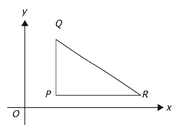Hi All,
We're given a triangle in the xy-plane. We're asked if the angle QPR a right angle. This is a YES/NO question. When dealing with pictures in DS questions, it's important to note that the picture is NOT NECESSARILY drawn to scale. Thus, we have to rely on FACTS to answer the given question - and not the picture that we've been given.
1) Points P and Q have the same X-coordinate.
With the information in Fact 1, we know that segment PQ is parallel to the Y-axis (the segment goes 'straight-up-and-down'), but we don't know where point R is relative to this segment, so there's no way to know whether we have a right angle or not.
Fact 1 is INSUFFICIENT
2) Points P and R have the same Y-coordinate.
With the information in Fact 2, we know that segment PR is parallel to the X-axis (the segment goes 'straight-left-to-right'), but we don't know where point Q is relative to this segment, so there's no way to know whether we have a right angle or not.
Fact 2 is INSUFFICIENT
Combined, we know:
-PQ is parallel to the Y-axis
-PR is parallel to the X-axis
By definition, since we have a triangle with legs that are parallel to the 2 axes on a graph (and thus, perpendicular to one another), then we ARE dealing with a right triangle - so the answer to the question is ALWAYS YES.
Combined, SUFFICIENT
Final Answer: C
GMAT assassins aren't born, they're made,
Rich

